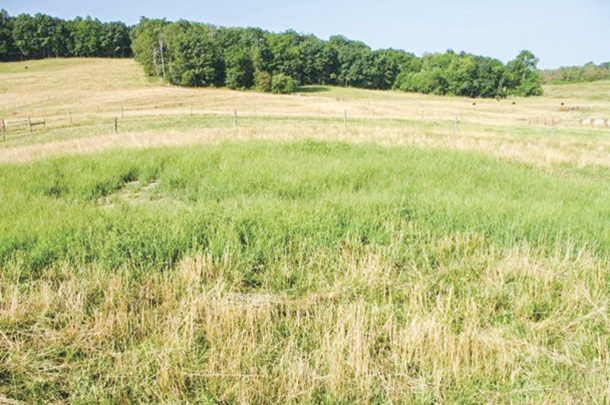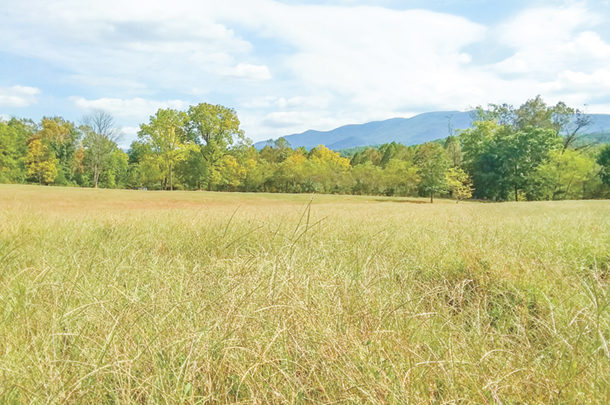In most people’s minds, the wet winter pretty much guaranteed we would have a whopping summer drought (they turned out to be right, of course), so they were also looking for a forage that would provide some summer grazing. Could crabgrass provide a silver bullet solution?
While many livestock graze on it where it grows wild, there is not widespread experience and use of forage crabgrass in many of the areas for which it is well adapted. A warm-season annual grass, crabgrass can grow quickly to shade out annual weeds, in addition to providing palatable and nutritious summer feed. It is heat tolerant and regrows abundantly after grazing if moderate moisture and fertility is available. While wild populations of crabgrass possess all of these characteristics, limited, but successful, selections of naturalized crabgrass over the years have resulted in several improved varieties that offer greater yield and different maturity options.
We wanted to get a feel for how well an improved variety of crabgrass simply broadcasted into damaged pastures would live up to its potential to provide feed, cover and to smother weeds. In spring 2019, the Augusta office of Virginia Cooperative Extension offered a crabgrass seed pool in an effort to gather information across a wide variety of environments and management. Two improved forage varieties were offered: Quick-N-Big and Dal’s Big River – both from Dalrymple Farm in Thomas, Oklahoma. Cattle and sheep producers in and around Virginia’s Shenandoah Valley participated in the seed pool, resulting in a total of about 250 acres overseeded on 35 farms. At the end of the season, they reported their experiences to be included in a summary.
The majority of farmers in the pool broadcasted seed directly onto denuded pastures from mid-April through May. About half of them used a pasture drag or other implement to incorporate the seed and smooth up the ground afterward. The recommended seeding rate was 5 pounds of pure live seed per acre, and most participants said they stuck close to that. While a 5-pound rate is a little heavier than what is typically recommended, most of the farmers had a goal of smothering out weeds, so a thicker cover was desireable. We had enough rain throughout early summer that moisture should not have been a factor in establishment. By late summer, many areas were under full drought conditions, which surely played a role in the final impression left on participants.
What we learned
There was a remarkably even split in those reporting good performance from their crabgrass and those who said, it didn’t do “squat.” The obvious question is: Why the difference? Crabgrass seed is not cheap, so it’s no surprise to me that people felt pretty strongly in one direction or the other. However, it may also be that in the world of annual forages, it is usually either boom or bust. I’ve experienced this with field crops like millet or sudangrass but even more so when seeding into established pastures with annuals like Korean lespedeza or crabgrass.

One factor at play is establishment, and assuming there is usually enough rain to get germination, my first suspect in any establishment failure with small-seeded annuals is usually seeding depth. Crabgrass has a very small seed that needs to remain at about 1/2-inch deep or less to establish successfully. I have a hunch those farmers that harrowed aggressively after seeding probably buried a lot of their seed too deeply; those that just broadcasted seed on the surface and let Mother Nature incorporate it probably got it just right.
Once seedlings establish, the main cause of failure with annuals seeded into pasture is often competition from an established sod or from early germinating weed species that get a jump on whatever you’ve planted. From my conversations with farmers in the seed pool and my observations in the field, this seemed to be the top reason why some of the crabgrass seedings failed.
Prior to last year, I didn’t have a full appreciation for just how resilient an established pasture sod can be. As previously mentioned, denuded, muddy pastures were widespread. Many areas that were pugged and churned and later hardened like concrete – areas in which we were certain no plant could survive – bounced back with orchardgrass, fescue and clover like nothing ever happened. Of course, there was some nuance, but the point is not to underestimate the competitiveness of your existing pasture. If you plan to give thin or damaged pastures a boost with annual forages, I would advise to make sure it is truly a sparse stand or bare area beyond just superficial appearances. Knowing the condition of pastures prior to extreme weather will be an important guide in planning for any repair strategies.
As for the seedings that worked, these producers reported their crabgrass came up quickly, shaded out the pigweed and cocklebur that grew unchecked in other areas, and supplied invaluable forage during our summer drought. I’ve been involved in seeding annual forages like crabgrass (annual lespedeza) before, and it’s worth noting that seed costs are usually somewhere around $20 to $40 per acre, so it can be a relatively expensive feed insurance policy. But you can manage it to go to seed, so it will volunteer in future years.
All things considered, crabgrass can be an effective and easy way to enhance your grazing system. But you have to pay attention to agronomy basics like seed placement and site selection – in other words, crabgrass may be a silver bullet, but you still have to keep your eyes open and aim when you pull the trigger. ![]()
PHOTO 1: Crabgrass seeded around winter feeding areas can help smother summer annual weeds.
PHOTO 2: In this pasture, crabgrass is being managed to go to seed. Photos by Matt Booher.

-
Matt Booher
- Crop and Soil Extension Agent
- Virginia Cooperative Extension – Augusta County
- Email Matt Booher










